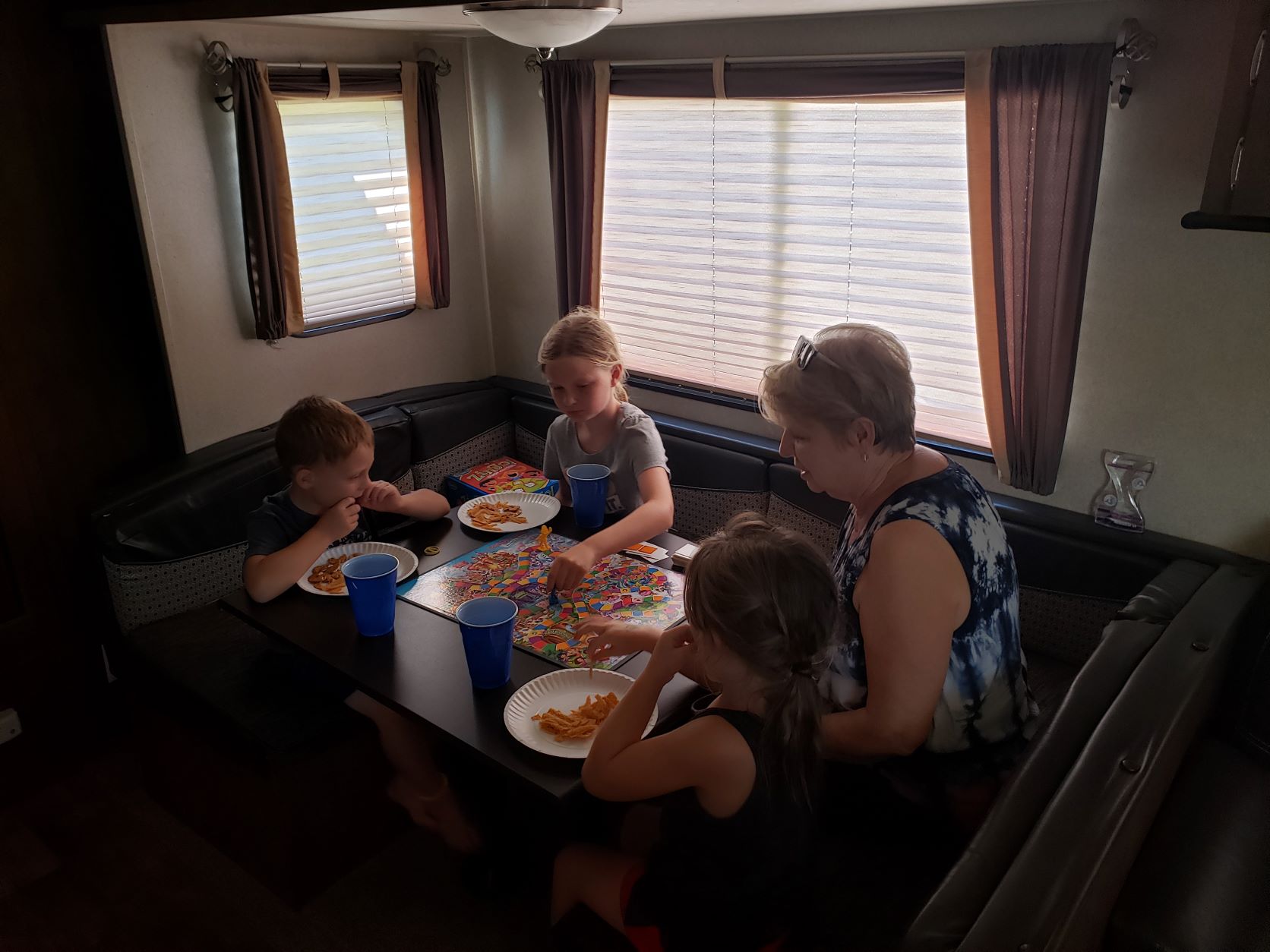An unstable RV table is more than a nuisance. It can quickly become a projectile, and it causes several issues in your daily operations. Fixing the problem quickly and correctly is necessary for safe and proper travel.
You can make your RV table more sturdy by:
- Checking and tightening loose bolts or screws
- Sliding shims under the pedestal or legs
- Adding weight to the table
- Leveling the unstable table
- Replacing the pedestal mount
- Adding additional support beams
This article explores some quick solutions that make your RV table sturdy before diving into more intensive repair and replacement methods.
Don’t forget to check out our Recommended RV Equipment list!
Quick Solutions to Make Your RV Table More Sturdy
If you are in a rush or want to try moving forward without serious repairs, there are a few ways to make your RV table more sturdy.
Checking Existing Bolts and Screws
The most straightforward issue to address is noticing and tending to any loose bolts or screws. These are mainly located where the leg secures to the tabletop and on the pedestal mount on the floor surrounding the leg’s base.
If you notice loose bolts or screws, you can tighten them with an appropriately sized wrench or screwdriver.
A common issue you will face at this point is a screw that has stripped its screw hole. In this instance, you need to replace it with a larger screw, either one with a thicker diameter, one that is longer than the original, or ideally, a screw that is larger in both dimensions.
Take the existing screw to the hardware store to help you locate a suitable replacement. Ensure the screw head remains the same size and sits flush in the plate.
As long as this is the only issue, correcting any existing bolts and screws will make your RV table more sturdy.
Sliding Shims Under the Pedestal or Legs
Sliding shims or slim objects under a wobbly pedestal or table leg can temporarily level it and make your RV table more sturdy.
This solution works best if you only need minor adjustments and have material at hand to slide between the floor or tabletop and the leg or pedestal. You will require pressure from both sides to keep the shim in place until you can properly secure it to level the surface permanently.
You can purchase wooden or metal shims or use random materials such as:
- Folded cardboard
- Wood scraps
- A matchbox
- Old gift cards
- Duct Tape
- Coins
You should also use a level to ensure proper orientation, but because this is not a permanent solution, then eying the level should be fine. Slide the material between the surfaces, and add as much as you need to secure the RV table.
This will work for minor adjustments, but you will need to install permanent shims later. You may also uncover a larger issue that requires greater attention.
Adding Weight to the Table
RV tables are not heavy, and their slight weight contributes to the unstable nature of an RV table. You can add weight to the table’s surface while your RV is stationary to counterbalance any other weight you put on the table.
This is easiest with a table that uses a single pedestal in the center to support its weight, as decor in the center will double down on the pressure for the support.
Examples include:
- A vase of flowers (with water)
- Centerpiece decor
- Centerpiece storage (for napkins, utensils, etc.)
If you’re attempting to make an RV table that folds down more securely, you can add weight blocks to the outlying edge or legs. The extra weight helps pull the table down to rest on the legs, so it sits stable when you pull it down.
Leveling an Unstable RV Table
If you’re dealing with an RV table that is persistently or egregiously unlevel, you need to address the issue with a permanent solution. If you do not notice the shaking of the leg within the pedestal, this is the route you should take.
You need:
- Drill and a screwdriver
- Appropriately sized drill bits (if replacing screws)
- Screws (if replacing)
- Spirit level
- Wooden shims
Before you make any adjustments, make sure your RV sits level. Failing to do so will lead to an unlevel table surface.
Once the RV sits appropriately, place the spirit level on the table surface and note which side is lower. This is opposite the side where the bubble rises, where your first shim will go.
Start by loosening the screws on the pedestal mount around the base of your table leg. This allows you to fit shims underneath it to level the RV table.
While holding the tabletop with your non-dominant hand, use your other hand to slide wooden shims between the pedestal mount and the floor. Add another shim on the opposite side to balance it out.
The shims should sit firmly in their spot. If you notice the table is still unlevel or insecure, you may need to remove screws entirely to slide shims under these areas.
Continue doing this until you notice the bubble sits in the center of your spirit level.
When you secure the table to the floor, drill slowly to avoid cracking the wood of the shims. We suggest you drill pilot holes when replacing screws or moving through the shims, but slow screwing should work in a pinch.
Replacing an RV Table Pedestal Mount
The RV table’s pedestal mount is the round bracket that secures to the floor and wraps around the leg of the table. The issue with most RV table pedestals is that they are hollow on the inside.
As you move your RV, people sit at the table, or objects sit on the table; the leg moves inside the pedestal and slowly causes the opening to widen. This reduces the pedestal’s ability to hold the table leg securely, and it causes the table to wobble.
You need:
- New pedestal mount
- Extra screws (no specific size)
- Cold welding compound
- 200- or 300- grit sandpaper
- Paper plate
- Mixing stick
- Straight edge
- Gloves
- Drill
Contact the table manufacturer to find a proper replacement. You can usually find the manufacturer information on a sticker on the bottom of the tabletop. You can also purchase an aftermarket pedestal mount that properly fits the diameter of the table leg.
Flip the new pedestal mount upside down and scrape the interior with your sandpaper. Ensure you get every inch of the inner surface so the cold welding compound has an appropriate surface to adhere to.
Put on your thick working gloves before mixing the cold welding compound. This should come in two tubes; you will need to use a mixing stick or other disposable items to stir the gels together. This activates the compound so it can bind with the metal.
Fill the interior of the pedestal about halfway with screws. The screws act similarly to rebar in this smaller situation and reinforce the compound.
After this, you can add the cold weld compound. It does not matter if some screws stick up through the compound, but you should use a hard edge to remove anything that extends beyond the bottom edge of the pedestal.
Let it sit for at least 24 hours to dry thoroughly, even if the compound notes 12 hours to dry. This is a thick layer of the compound. Leave the windows open so that any fumes can air out properly. They are not toxic, but the smell is offensive.
While you do this, you can remove the old pedestal. Unscrew any support screws and hold onto them to reuse. Unscrew any hinges connected to the table (if applicable) and then remove the table.
Secure the new, reinforced pedestal mount to the exact location, then reset the table. The cold weld and screws will prevent the table leg from bending the metal out, increasing the stability and longevity of your RV table.
Adding Additional Support Beams
Adding additional support beams further anchors your table to the floor. You usually situate them at the center of the table, near the pedestal, so they do not interfere with leg room much, but they still cause issues here.
You need:
- 2 x 2 hardwood beam
- 4 L-brackets (per beam)
- Measuring tape
- Carpentry pencil
- Screws
- Protective eyewear
- Dust mask
- Sawhorses
- Gloves
- Circular saw or handsaw
- Drill
An 80-inch beam suffices to create two support beams to make your RV table more sturdy. To get the beam’s exact size, measure the distance between the points you plan to secure the wood to the table and the floor.
Once the beams are cut to size, cut a 45° angle to each wood end. Ensure the flat edges match where you will anchor the wood. For example, securing the floor requires cuts occurring on opposite sides.
Secure L brackets on the top cut so you can attach them to the tabletop. Line these up flush with the edge of the wood, then use 1- or 1.5-inch screws to secure them to the wood.
For the two brackets on the base, ensure they are flush with the bottom cut and edge. Orient them properly to secure them to the floor or the wall.
Once all four brackets are secure, anchor them to the tabletop and the other location. Make sure you use screws small enough that they do not surpass the table’s surface, but use longer screws on the other end.
Don’t forget to check out our Recommended RV Equipment list!
Get a FREE copy of the Go Together Go Far Travel Trailer Hookup and Disconnect Checklist when you sign up for the Go Together Go Far Newsletter!
Want to learn more about different types of RVs? Check out:
- Best Off-Road Camper Trailer Under $10,000
- Best Bunkhouse Travel Trailer Under 30 Feet
- Are Lance Travel Trailers Any Good?
- Do Rope Lights Deter Rodents?
- What Are the Best Names in the RV Industry?
- 3 Best Travel Trailers for Family of Four
- Blue Ox SwayPro Basics: Top Questions Answered
- Adding A Washer Dryer To Travel Trailer? What You Need To Know.
- Best Drone For Camping, Backpacking, and RVing: A Complete Guide to Drones for RVers
- Furniture and RVs – How To Get It Through the Door…
- How To Get Rid Of A Poop Pyramid In RV Black Tank
- Do You Know How Long To Keep Fresh Water In RV Tank Storage?
- What Is The Best Outdoor Security Camera System For Your RV?
- RV Bumper Mount Grills: 5 Best Options For Your RV Or Camper
- Best Electric Tankless Water Heater for Your RV. What You Need To Know
- Read Before You Buy! How to Find the Best Scooter for RV Camping
- 3 Best Travel Trailers for Family of Four
- Top RV Brands: What Are the Best Names in the RV Industry?
- Lance Campers: What Makes Them So Different?
- Best Bunkhouse Travel Trailer Under 30 Feet
- Best Off-Road Camper Trailer Under $10,000
- Best Weight Distribution Hitch With Sway Control For Travel Trailers in 2022
- What Are The Best Built Travel Trailers? Things To Consider.
- How Does An RV Refrigerator Work? A Quick Guide.
- Why Does My RV Carbon Monoxide Detector Keep Beeping? A Quick Guide.
- Where Is The Power Converter In My RV Or Travel Trailer
- What is the Best Generator for 50 Amp RV?
- Wireless RV Security Camera Systems: Is Solar Powered Security Without Wi-Fi An Option?
- Best Portable Air Conditioner for Camping for 2022
- How to Find the Best 3500 Watt Inverter Generator for RV Camping
- Best Propane Generator For Your RV: Read This Before You Buy!


